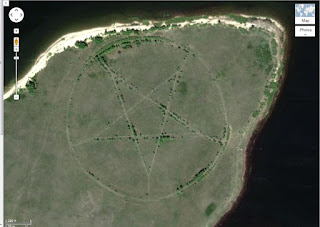Google Maps is a web planning stage and customer application presented by Google.It offers satellite images, aerial photography, road maps, 360° intelligent of all roads, live traffic conditions, and and route planning for traveling by foot, vehicle, air and public transportation.
But there are some mysterious thing found on Google Maps.
island-in-a-lake-on-an-island-in-a-lake-on-an-island
This Google Earth picture is an eye-full and a significant piece, as it's an island-in-a-lake-on-an-island-in-a-lake-on-an-island. Indeed, Google Earth caught this picture showing a small island that lives inside a hole lake on an island called Volcano Island in a lake called Lake Taal on the Philippine island of Luzon. For quite a long time evidently, this marvel was believed to be the biggest of its sort spied by Google Earth. In any case, it just so happens, honor goes to a 4-section of land spit of land in northern Canada where no human has likely gone.
- Tap on that Link to explore the place.
Egyptian Pyramids
A satellite archeological researcher from North Carolina professes to have discovered pictures of locales in Egypt that might be lost pyramids and other man-made designs. Found 90 miles separated along the Nile River, the satellite pictures show hills of earth in odd groupings and provisions surprising for the regular habitat. One picture shows four particular hills with a bigger three-sided formed level; one more hopes to contain a four-sided mount around 150 feet wide; and a third shows three little hills in a comparable design to the Giza Plateau pyramids.
Sandy Island
In 2012, a gathering of Australian analysts "unseen" an island the size of Manhattan in the South Pacific. A baffling spot called Sandy Island had sprung up on maps, northwest of New Caledonia. It even displayed as a dark polygon on Google Earth. Yet, when researchers cruised there in November 2012, they discovered open water rather than strong ground.
Puzzling Pentagram
On the wind-blown steppes of central Asia, in an isolated corner of Kazakhstan, there's an enormous pentagram, measuring approximately 1,200 feet (366 meters) in width, carved into Earth's surface. The five-pointed star encompassed by a circle, situated on the southern shore of the Upper Tobol Reservoir, appears strikingly on Google Maps, the online version of the more nitty gritty Google Earth.
Abandoned Launch Sites
Nike missiles, which were supersonic surface-to-air missiles, sat prepared to dispatch at almost 300 destinations across the United States during the period from 1954 to the 1970s. A portion of those missiles even conveyed nuclear warheads. Those missiles became old with the approach of long-range intercontinental ballistic missiles (ICBMs).
Desert Breath
A spiral portal to an alternate universe? Maybe an alien message? Or an ancient monument to a supernatural being? This giant spiral design in the desolate Egyptian desert, not far from the shores of the Red Sea, is an art installation called Desert Breath. In March 2007, Danae Stratou, Alexandra Stratou and Stella Constantinides created the 1 million square foot (100,000 square meters) artwork meant to celebrate "the desert as a state of mind, a landscape of the mind," the artists say on their website.
- Tap on that Link to explore the place
Riddled With Holes
The civil war in Syria has imperiled hundreds of archeological sites, including causing harm to each of the six of the UNESCO World Heritage Sites in the country, which is viewed as one of the most established involved spaces of the Earth. Satellites, specifically, have shown quite a bit of this decimation, with the absolute most abnormal symbolism showing annihilation in Apamea. There, Google Earth images have revealed the entire ancient Roman city has been pockmarked with holes dug by looters since the start of the civil war.
Lake Of Blood?
Outside Sadr City in Iraq, at arranges 33.396157° N, 44.486926° E, lies a dark red lake. There is, at this point, no official clarification for the shade of this strange body of water.
- Tap on that Link to explore the place.
Biggest Word?
Hamad bin Hamdan al Nahyan, a billionaire Sheik and individual from Abu Dhabi's decision family, has had his name cut into the sandy surface of al Futaisi Island, an island he possesses in the Persian Gulf. At half a mile tall and 2 miles in length altogether, the letters HAMAD might be the world's largest; in any case, they're apparent from space. Normally, words written in sand wash away, but these letters are large enough to form waterways that absorb the encroaching tide.
Sizable Shipwreck
The S.S. Jassim, a Bolivian cargo ship, steered into the rocks and sank on the Wingate Reef off the bank of Sudan in 2003. At 265 feet (81 meters) in length, it is currently perhaps the biggest wreck apparent on Google Earth, and is situated at 19° 38' 46.00" N, 37° 17' 42.00" E.
- Tap on that Link to explore the place.













Nice..
ReplyDeleteThank You
DeleteExcellent
ReplyDeleteStay Connected!!!
Delete